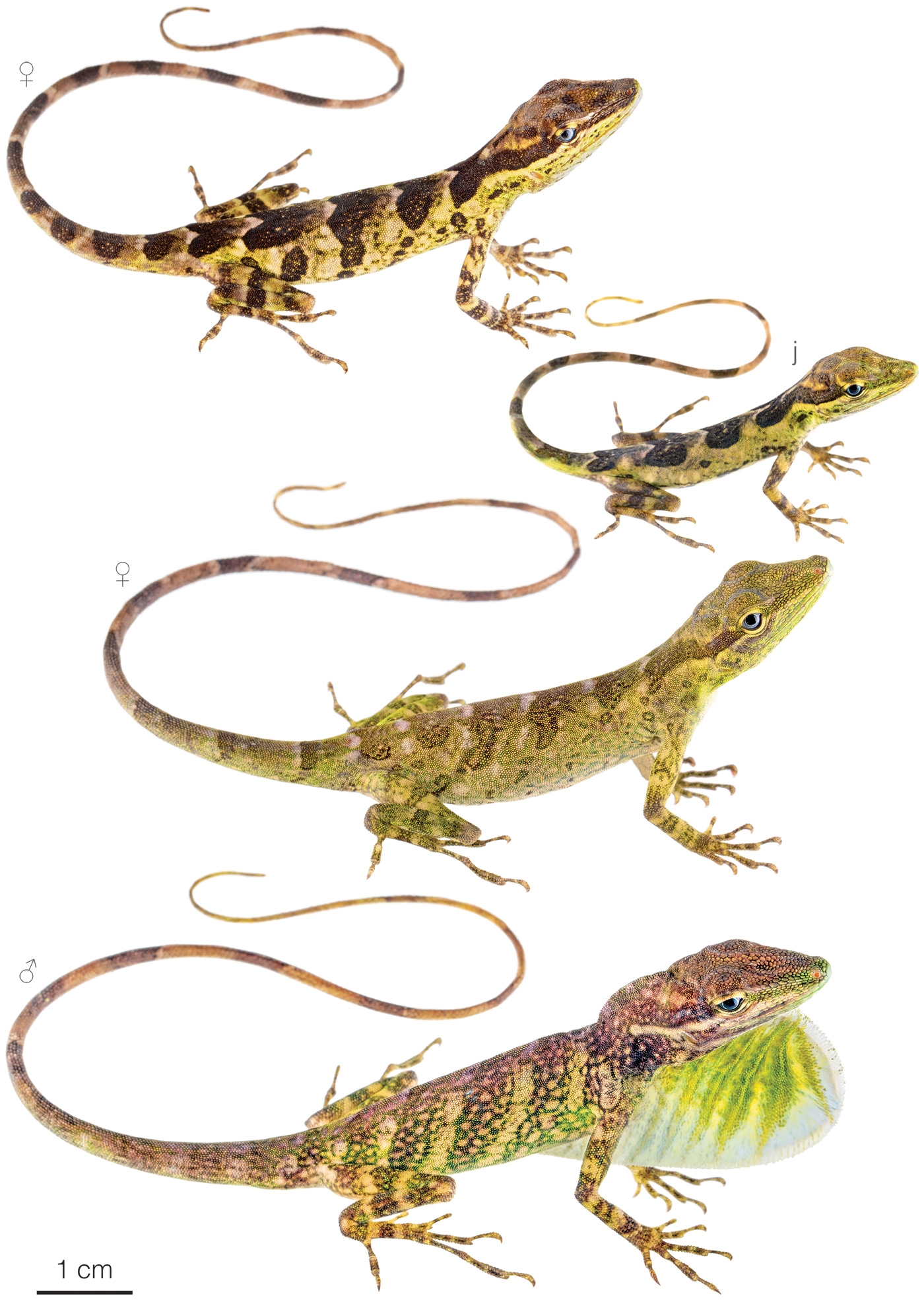Published June 29, 2023. Updated October 28, 2023. Open access. | Purchase book ❯ |
Otonga Anole (Anolis otongae)
Reptiles of Ecuador | Sauria | Anolidae | Anolis otongae
English common name: Otonga Anole.
Spanish common name: Anolis de Otonga.
Recognition: ♂♂ 22.3 cmMaximum distance from the snout to the tip of the tail. Snout–vent length=6.6 cm. ♀♀ 22.6 cmMaximum distance from the snout to the tip of the tail. Snout–vent length=6.7 cm..1,2 Anoles are easily distinguishable from other lizards by their diurnal habits, extensible dewlap in males, expanded digital pads, and granular scales on the dorsum and belly. The Otonga Anole (Anolis otongae) co-occurs with A. aequatorialis and A. gemmosus.2 From the former, it differs by lacking a dewlap in females and by having a male dewlap lacking black reticulations (Fig. 1). From the latter, it differs by being larger in body size, having a dark coppery brown stripe along the sides of the head, and dark brown dorsal chevrons in females.2

Figure 1: Individuals of Anolis otongae from Otonga Reserve, Cotopaxi province, Ecuador. j=juvenile.
Natural history: Anolis otongae is the least common of the three anole species present within the Otonga Reserve.2 This species inhabits a variety of environments, including old-growth cloud forests, forest edges, riparian forests, and pastures with scattered trees.2 Otonga Anoles exhibit activity both on cloudy and sunny days, often found on stems and ferns in the understory of the cloud forest.3 During the night, they adopt a head-down sleeping posture, perched on leaves and ferns at a height of 120–150 cm above the ground.1,4 Males are known to defend territories and court females through the use of visual signals, including head bobs and dewlap displays.3 Gravid females containing two eggs have been reported,2 but the real clutch size is probably one egg.
Conservation: Vulnerable Considered to be facing a high risk of extinction in the mid-term future..5 Anolis otongae is listed in this category because the species is known only from an extremely small (here estimated to be under 200 km2) cloud forest area that continues to decline in extent and quality due to deforestation.5 Only five localities are known, they lack connectivity between them, and are under continuing threat of disappearance due to the expansion of the agricultural frontier. Fortunately, one of the populations is protected in Otonga Reserve.
Distribution: Anolis otongae is endemic to the Pacific slopes of the Andes in west-central Ecuador (Fig. 2).

Figure 2: Distribution of Anolis otongae in Ecuador. The star corresponds to the type locality: Otonga Reserve, Cotopaxi province. See Appendix 1 for a complete list of the presence localities included in the map.
Etymology: The generic name Anolis is thought to have originated from Cariban languages, specifically from the word anoli, which is the name Arawak peoples may have used to refer to this group of lizards.6 The epithet otongae refers to the type locality: Otonga Reserve.2 The Bosque Integral Otonga is a 1500 hectare cloud forest reserve in Cotopaxi province.
See it in the wild: The best location to find Otonga Anoles is undoubtedly the Otonga Reserve. While these lizards are active during the day, they are most readily spotted at night when they are perched on low vegetation. Their bright green coloration stands out prominently when illuminated with a flashlight.
Author: Alejandro ArteagaaAffiliation: Fundación Khamai, Reserva Arlequín, Ecoruta Paseo del Quinde km 56, Santa Rosa de Mindo, Pichincha 171202, Ecuador.
Photographer: Jose VieirabAffiliation: Tropical Herping (TH), Quito, Ecuador.,cAffiliation: ExSitu, Quito, Ecuador.
How to cite? Arteaga A (2023) Otonga Anole (Anolis otongae). In: Arteaga A, Bustamante L, Vieira J (Eds) Reptiles of Ecuador: Life in the middle of the world. Available from: www.reptilesofecuador.com. DOI: 10.47051/MVVI8428
Literature cited:
- Ayala-Varela F, Carvajal-Campos A (2020) Anolis otongae. In: Torres-Carvajal O, Pazmiño-Otamendi G, Ayala-Varela F, Salazar-Valenzuela D (Eds) Reptiles del Ecuador. Museo de Zoología, Pontificia Universidad Católica del Ecuador. Available from: https://bioweb.bio
- Ayala-Varela F, Velasco J (2010) A new species of dactyloid anole (Squamata: Iguanidae) from the western Andes of Ecuador. Zootaxa 2577: 46–56. DOI: 10.11646/zootaxa.2577.1.2
- Video by Andrea Narváez.
- Field notes, Reptiles of Ecuador book project.
- Arteaga A, Cisneros-Heredia DF (2019) Anolis otongae. The IUCN Red List of threatened species. Available from: www.iucnredlist.org. DOI: 10.2305/IUCN.UK.2019-2.RLTS.T50950385A50950388.en
- Allsopp R (1996) Dictionary of Caribbean English Usage. Oxford University Press, Oxford, 776 pp.
Appendix 1: Locality data used to create the distribution map of Anolis otongae in Ecuador (Fig. 2). Go to the section on symbols and abbreviations for a list of acronyms used. Asterisk (*) indicates type locality.
| Country | Province | Locality | Source |
| Ecuador | Cotopaxi | Chugchilán–Pucayacu road | QCAZ 14420; Ayala-Varela & Rodríguez-Guerra 2020 |
| Ecuador | Cotopaxi | Otonga, Cuchilla | Ayala-Varela & Velasco 2010 |
| Ecuador | Cotopaxi | Peñas Coloradas | Ayala-Varela & Velasco 2010 |
| Ecuador | Santo Domingo de los Tsáchilas | La Victoria | Ayala-Varela & Velasco 2010 |